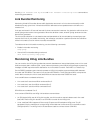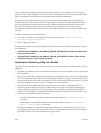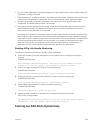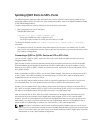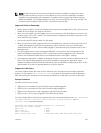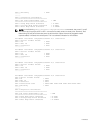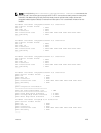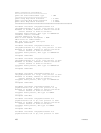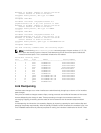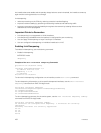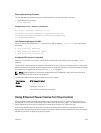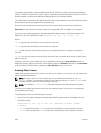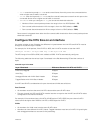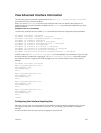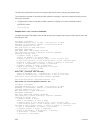
Hardware is DellEth, address is 90:b1:1c:f4:9a:fa
Current address is 90:b1:1c:f4:9a:fa
Pluggable media present, SFP type is 1GBASE
……………………
LineSpeed 1000 Mbit
Dell#show interfaces tengigabitethernet 0/7
gigabitethernet 0/0 is up, line protocol is down
Hardware is DellEth, address is 90:b1:1c:f4:9a:fa
Current address is 90:b1:1c:f4:9a:fa
Pluggable media present, SFP type is 1GBASE
……………………
LineSpeed 1000 Mbit
Dell#show interfaces tengigabitethernet 0/8
TenGigabitEthernet 0/0 is up, line protocol is up
Hardware is DellEth, address is 90:b1:1c:f4:9a:fa
Current address is 90:b1:1c:f4:9a:fa
Pluggable media present, QSFP type is 4x10GBASE-CR1-3M
……..
LineSpeed 10000 Mbit
The show inventory command shows the following output:
NOTE: In the following show inventory media command output, the port numbers 1, 2, 3, 5, 6,
and 7 ports are actually inactive. However, Dell Networking OS still shows that optical cables are
inserted into these ports. This is a software limitation for this release.
Dell# show inventory media
Slot Port Type Media Serial Number
-------------------------------------------------------------------
0 0 SFP+ 10GBASE-SX APF12420031B3P
0 1 SFP+ 10GBASE-SX APF12420031B3P
0 2 SFP+ 10GBASE-SX APF12420031B3P
0 3 SFP+ 10GBASE-SX APF12420031B3P
0 4 SFP 10GBASE-SX APF12420031B3P
0 5 SFP 10GBASE-SX APF12420031B3P
0 6 SFP 10GBASE-SX APF12420031B3P
0 7 SFP 10GBASE-SX APF12420031B3P
0 8 QSFP 4x10GBASE-CR1-3M APF12420031B3P
0 9 QSFP 4x10GBASE-CR1-3M APF12420031B3P
0 10 QSFP 4x10GBASE-CR1-3M APF12420031B3P
0 11 QSFP 4x10GBASE-CR1-3M APF12420031B3P
0 12 QSFP 40GBASE-SR4
Link Dampening
Interface state changes occur when interfaces are administratively brought up or down or if an interface
state changes.
Every time an interface changes a state or flaps, routing protocols are notified of the status of the routes
that are affected by the change in state. These protocols go through the momentous task of re-
converging. Flapping; therefore, puts the status of entire network at risk of transient loops and black
holes.
Link dampening minimizes the risk created by flapping by imposing a penalty for each interface flap and
decaying the penalty exponentially. After the penalty exceeds a certain threshold, the interface is put in an
Error-Disabled state and for all practical purposes of routing, the interface is deemed to be “down.” After
Interfaces
431



